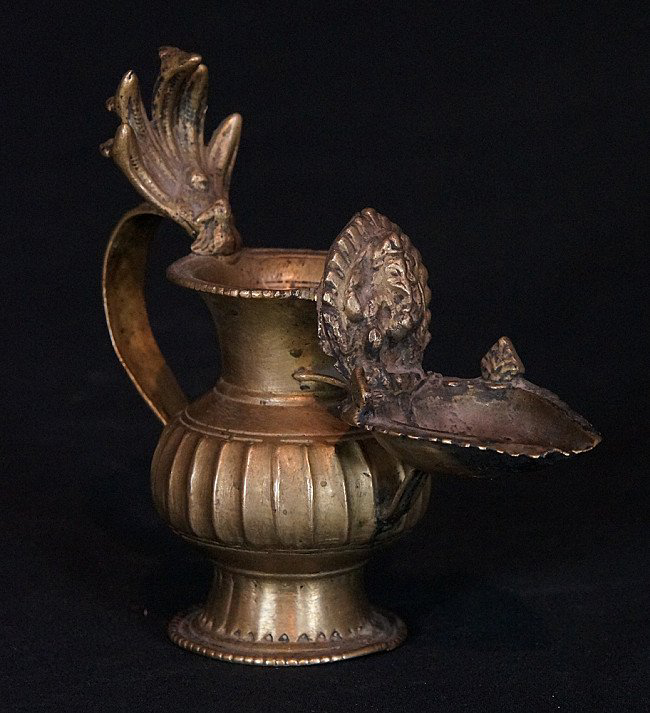Sukunda is a typically traditional Nepali oil lamp made of metals usually brass or silver .The front part of this lamp shows a tiny icon of Ganesha, the god of luck and success. In its front is a tiny cup fixed to put the wick in it. Fixed on the back of the lamp is a fascinating loop handle designed with a five-headed serpent (sometimes a mythical dragon) raising its head in a very watchful attitude.
Pic : Lighted SukundaBoth the shape and figures that decorate sukunda are rife with symbolic meaning. Its form is connected to the origin of the Kathmandu Valley which was, millions of years ago, a vast lake said to be the home of many snake gods. This is further evidenced by its name. “Su” translates to beautiful and “kunda” to lake.
Kathmandu Valley from top of Swayambhunath. Pic by : Clarence Comyn Taylor, 1863
The artistic work on this unique oil lamp reflects the remote past of a very famous Buddhist legend.
A long time ago, Kathmandu valley was a large lake inhabited by nags(snakes). In the middle of the lake was a beautifully blooming thousand-petalled lotus flame. When Boddhisattwa Mahamanjushree heard all about this, he rushed to the valley all the way from China to pay homage to the flame. The entire valley rang up with the thundering strike of his magic sword on the southern hill of the lake, which drained the entire water from the lake leaving the valley floor open to all.
The most famous Buddhist stupa of Nepal locally known as Swayambhubatha is believed to have originated from the same legendary lotus flame. The cut where the water drained out is now known as Kwaina. (Kwaina Ganesh).
It is interesting to note that the word Sukunda, means a beautiful lake in the Nepal Bhasa (Newar language). The Sukunda story in many ways sounds like an artistic fact in fiction. It is said that the oil reservoir of Sukunda represents the legendary lake and its wide-open mouth represents the full-blown thousand-petalled lotus and the cup attached to it in which the lamp is lighted by the self-existent divine lotus flame. The snake hood over the Sukunda and the snake spoon half dipped in its oil reservoir symbolize the nagas (snakes), original inhabitants of the legendary lake. The lamp cup symbolizes Swayambhu Jyotir-linga meaning the self-existent divine light.
Sukunda are key to many important Newar ceremonies surrounding birth and death. It is also important in marriage ceremonies. A procession would form at the house of the groom and then travel with lamp lit to the home of the bride and back again after she had joined the procession.
Lamps were alternatively used as parts of home altars or in the more complex ritual arrays of monasteries. In the Hindu tradition lamp light serves for literal and symbolic illumination: the light is divine, bringing good fortune to one’s family and protecting against the forces of evil that thrive in darkness.
The Kathmandu Valley that sukunda come from has been a major center of production for ritual artifacts since at least the 7th century. There Newar craftsmen cast ritual sculptures that were historically used locally and exported to parts of India and Tibet. Production tends to be rather conservative, evolving little over the course of hundreds of years. Even today Newar sculptors rely on knowledge passed down orally and, in some cases, modern Western art catalogues to replicate the proper proportions and iconography in contemporary sculptures. To create a sukunda like this a model is made in wax and then encased in clay. The wax is then melted out by pouring molten copper or brass into the mold. After the metal cools, the clay is shattered to reveal the metal beneath. In the case of statuary most pieces are fire gilded, a process which uses small quantities of gold and mercury to create gold coating to pieces.



Comments
Post a Comment